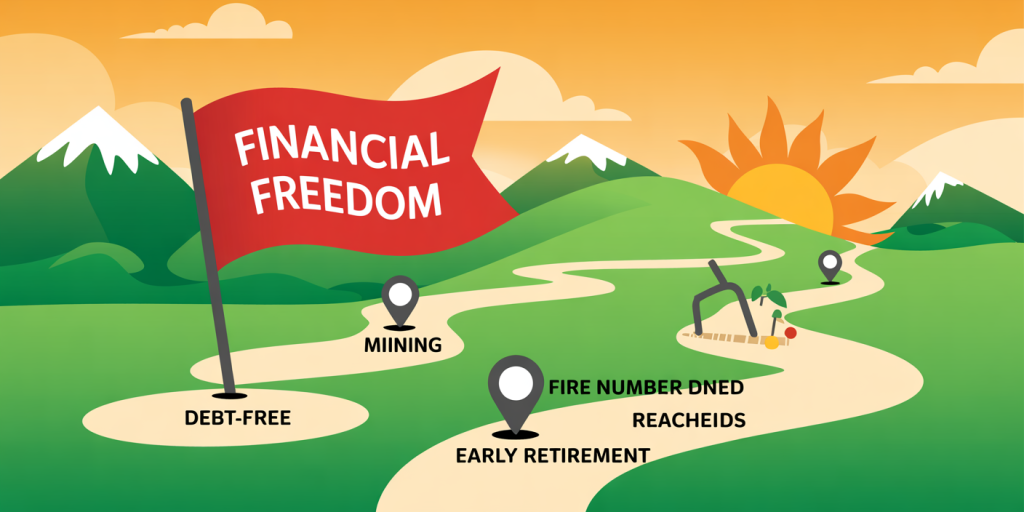What Is Financial Independence, Retire Early (FIRE), and Is It Right for You?
Anúncios
Imagine waking up each morning with no job to rush to, no boss to report to, and the freedom to spend your day however you choose. For many, this dream represents the essence of financial independence and early retirement—a lifestyle goal that has inspired a growing movement known as FIRE.
The FIRE movement, short for Financial Independence, Retire Early, has gained traction among millennials and Gen Z professionals who are rethinking traditional career timelines. But what exactly does FIRE mean, how does it work, and most importantly—is it the right path for you?
Let’s dive into the key concepts behind FIRE, its benefits and challenges, and how to evaluate whether this ambitious financial strategy aligns with your goals and lifestyle.
Anúncios
What Is FIRE?

At its core, FIRE is a financial lifestyle philosophy that encourages aggressive saving and investing in order to achieve financial independence and retire far earlier than the traditional retirement age of 65.
Anúncios
The idea is simple: If you can accumulate enough wealth to cover your living expenses through passive income or investment returns, you no longer need to work for money. Some FIRE followers aim to retire in their 30s or 40s, while others simply want the freedom to choose how they spend their time—whether that means quitting a 9-to-5 job, starting a passion project, or traveling the world.
The Two Key Phases of FIRE
1. Accumulation Phase
This is the period where you aggressively save and invest as much of your income as possible—often 50% or more. The focus is on:
-
Reducing living expenses to a bare minimum
-
Maximizing income through side hustles or career growth
-
Investing in low-cost index funds or real estate
-
Avoiding lifestyle inflation
The more you save and invest now, the faster your net worth grows.
2. Withdrawal Phase
Once you reach your target number (we’ll talk about that below), you begin withdrawing a small percentage of your investments annually to cover your living costs—typically using the 4% rule.
The goal is to make your portfolio last for decades, while maintaining a comfortable lifestyle free from mandatory work.
The 4% Rule and Your “FIRE Number”
A key concept in FIRE is calculating your FIRE number—the total amount you need invested to live off the returns indefinitely. This number is based on the 4% rule, which suggests you can safely withdraw 4% of your investment portfolio per year without running out of money.
Example:
If your annual expenses are $40,000, your FIRE number is:
$40,000 ÷ 0.04 = $1,000,000
Once you reach $1 million in investments, you could theoretically withdraw $40,000 annually, adjusting for inflation, and live off that amount indefinitely.
Some FIRE practitioners use more conservative rates (3.5% or even 3%) to account for market volatility, early retirement length, or healthcare uncertainties.
Variations of FIRE
FIRE is not a one-size-fits-all approach. Different subgroups have emerged, each with its own philosophy and intensity:
1. LeanFIRE
-
Requires very low annual spending, often $25,000–$40,000
-
Appeals to minimalists who are comfortable with frugal lifestyles
2. FatFIRE
-
Targets higher spending levels, such as $80,000–$100,000+
-
Suitable for those who want financial independence without sacrificing luxuries
3. BaristaFIRE
-
A hybrid approach where you save enough to partially retire, but still work part-time or pursue passion projects to supplement income
4. CoastFIRE
-
Focuses on investing early so that your portfolio can “coast” to full retirement without additional contributions, allowing you to take lower-paying, lower-stress jobs in the meantime
Benefits of Pursuing FIRE

There’s a reason so many people are drawn to the FIRE lifestyle—it offers some truly life-changing advantages.
🕒 1. Time Freedom
The ability to control how you spend your time is one of FIRE’s biggest appeals. Whether you want to travel, start a business, volunteer, or simply rest, FIRE gives you time wealth.
💰 2. Financial Security
Reaching financial independence means you’re no longer reliant on a paycheck. This reduces stress and gives you more freedom to say no to toxic work environments.
📉 3. Simpler Lifestyle
Many people pursuing FIRE adopt minimalist or low-consumption lifestyles, which can lead to greater satisfaction, less clutter, and a stronger connection to what truly matters.
📈 4. Early Investment Discipline
The intense savings strategy encourages better money habits, increased financial literacy, and smart investment planning early in life.
Challenges and Criticisms of FIRE
FIRE is not without controversy. Critics point to several potential downsides:
🩺 1. Healthcare Costs
Especially in the U.S., retiring early means losing employer-sponsored health insurance. Private insurance can be expensive and unpredictable.
📉 2. Market Risk
Early retirees are more vulnerable to sequence of returns risk—where a market downturn early in retirement can significantly reduce the longevity of your portfolio.
💵 3. Lifestyle Sacrifices
Saving 50–70% of your income may require major sacrifices—like skipping vacations, living in a tiny apartment, or cutting dining and entertainment. Not everyone is willing to live that frugally.
💬 4. Social Isolation or Identity Loss
For some, work provides social structure and a sense of purpose. Retiring early without a plan for meaningful activities can lead to boredom or a loss of identity.
Is FIRE Right for You?
FIRE is not for everyone—and that’s okay. It’s a deeply personal decision that depends on your values, risk tolerance, financial situation, and lifestyle preferences.
Ask Yourself:
-
Am I willing to save aggressively and live frugally for years?
-
Do I want to retire early, or do I just want more flexibility?
-
Can I handle the mental and emotional side of not working?
-
Do I have a plan for healthcare, taxes, and inflation?
-
What would I actually do with my time once I reach FIRE?
If the idea of reaching financial independence resonates with you—but full early retirement feels extreme—consider hybrid approaches like CoastFIRE or BaristaFIRE that offer balance and flexibility.
How to Start Your FIRE Journey
If FIRE interests you, here’s how to start building toward it:
1. Track Your Spending
Understand exactly how much you spend each month. Tools like YNAB, Mint, or Empower (formerly Personal Capital) are great for this.
2. Calculate Your FIRE Number
Multiply your annual expenses by 25 to find your basic FIRE target.
3. Cut Expenses Strategically
Look for ways to reduce big-ticket items like housing, transportation, and food without sacrificing quality of life.
4. Increase Income
Negotiate your salary, switch jobs, or start side hustles. FIRE is faster when your income grows while your spending remains stable.
5. Invest Aggressively
Put your money to work through tax-advantaged accounts (like IRAs and 401(k)s) and low-fee index funds. Consider using the “three-fund portfolio” strategy for simplicity and diversification.
6. Build an Emergency Fund
Before going full FIRE, have 6–12 months of expenses saved in cash to weather market volatility or unexpected expenses.
7. Stay the Course
FIRE is a long-term journey. Be patient, adapt as needed, and stay focused on your “why.”
Final Thoughts

Financial Independence, Retire Early is more than a savings plan—it’s a mindset shift. It challenges the traditional 40-year career path and asks, “What would life look like if you didn’t have to work for money?”
Whether you aim for full early retirement or just want more flexibility and freedom, exploring the FIRE philosophy can lead to greater financial awareness, better spending habits, and a more intentional life.
It’s not easy—but for many, the payoff is priceless.
Post Comment